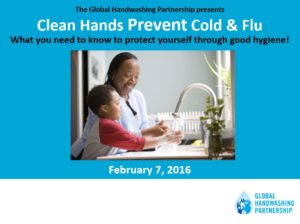Clean Hands Prevent Cold & Flu: Protect yourself through good hygiene
Published: February 7, 2017 / Published by Global Handwashing Partnership, CDC, American Cleaning Institute & St. Louis County Department of Public Health

This webinar summary highlights the role of hand hygiene in flu prevention, as well as the importance of integrated efforts between federal and provincial governments and non-profits in interventions.
Despite being easy to prevent, there are millions of cases of the cold and flu annually. In the United States, cold and flu season typically lasts from early October until May, with peak transmission in January and February. Flu infections can result in hospitalization and sometimes even death, particularly for vulnerable populations (e.g., infants, pregnant women, those living with chronic respiratory conditions and suppressed immune systems). Cold and flu infections represent the main health-related reasons for absenteeism from school and work, thus imposing a heavy toll on education and the economy. According to the U.S. Centers for Disease Control and Prevention (CDC), direct medical costs related to the flu are estimated at $10.4 billion a year.
As there is no vaccine for the common cold and the flu vaccine only reduces the risk of contracting the contagion, handwashing with soap is essential for preventing these two infections.
In this webinar, the Global Handwashing Partnership, the CDC, American Cleaning Institute, and the St. Louis County Department of Public Health examined and the consequences poor hand hygiene can have and outlined how handwashing with soap can increase protection against cold and flu. Presenters also highlighted how federal agencies, local governments, and nongovernmental organizations are innovating to combat these two infections.
The first presenter, Dr. Vince Hill, Branch Chief for the CDC Waterborne Disease Prevention Branch, spoke about the science of cold and flu germ spread. Dr. Hill discussed prevention methods, including handwashing with soap and the correct use of alcohol-based hand sanitizers when soap and water are not available. He also explained that handwashing with soap at key moments can prevent respiratory infections by 16-21% and can help reduce the likelihood of developing antibiotic resistance. Dr. Hill concluded by elaborating on how handwashing posters, sharing fact sheets, and celebrating Global Handwashing Day can help motivate people to wash their hands.
Visit the CDC website to learn more about handwashing and infection prevention here and view CDC-recommended strategies and materials here.
Martha Chapin, Associate Director of Education & Web Services for the American Cleaning Institute (ACI), explored the consequences of poor hand hygiene on the economy and education. Ms. Chapin explained that due to cold and flu infections, 20 million adults are unable to work each year, resulting in $16.3 billion in lost earnings; and that 22 million schooldays are lost each year, which also negatively impacts public funding for schools and places a financial burden on taxpayers. In the second half of her presentation, Ms. Chapin discussed ACI’s Healthy Schools, Healthy People, It’s a SNAP program. This joint-program with the CDC encourages proper handwashing habits amongst students, aims to reduce hygiene-related absenteeism, and helps the school community stay healthy. She explained how the program works and talked about the educational materials the program has developed for public use.
Learn more about ACI’s cold and flu prevention work here and view SNAP program resources here.
The last presentation was co-facilitated by Kyle Foerst, Emergency Response Planner, and Karla Howell, Registered Nurse and Communicable Disease Specialist, for the St. Louis County Department of Public Health. They shared the perspective of local and regional governments and explained the Department of Public Health’s response to cold and flu infections in their local community. Mr. Foerst then highlighted the conceptualization and key outcomes of the department’s recent public health campaign, Dirty Hands Can Be Scary, which collaborated with local transit agencies and St. Louis University’s public health centers to create an effective and innovative eye-catching campaign (view examples of the campaign’s visuals here).
Learn more about the key takeaways from these presenters and their organizations’ interventions by watching the webinar here. Presentations can be downloaded here.
- Resource Attachments:
- https://globalhandwashing.org/wp-content/uploads/2017/12/Clean-Hands-Prevent-Cold-Flu-slide-deck.pdf (pdf)
TAGS: Event RecordingBriefing PaperPresentation Advocacy & PolicyHygiene in SchoolsMaternal Newborn & Child Health ImplementersPolicy MakersGeneral PublicEducators English 2016